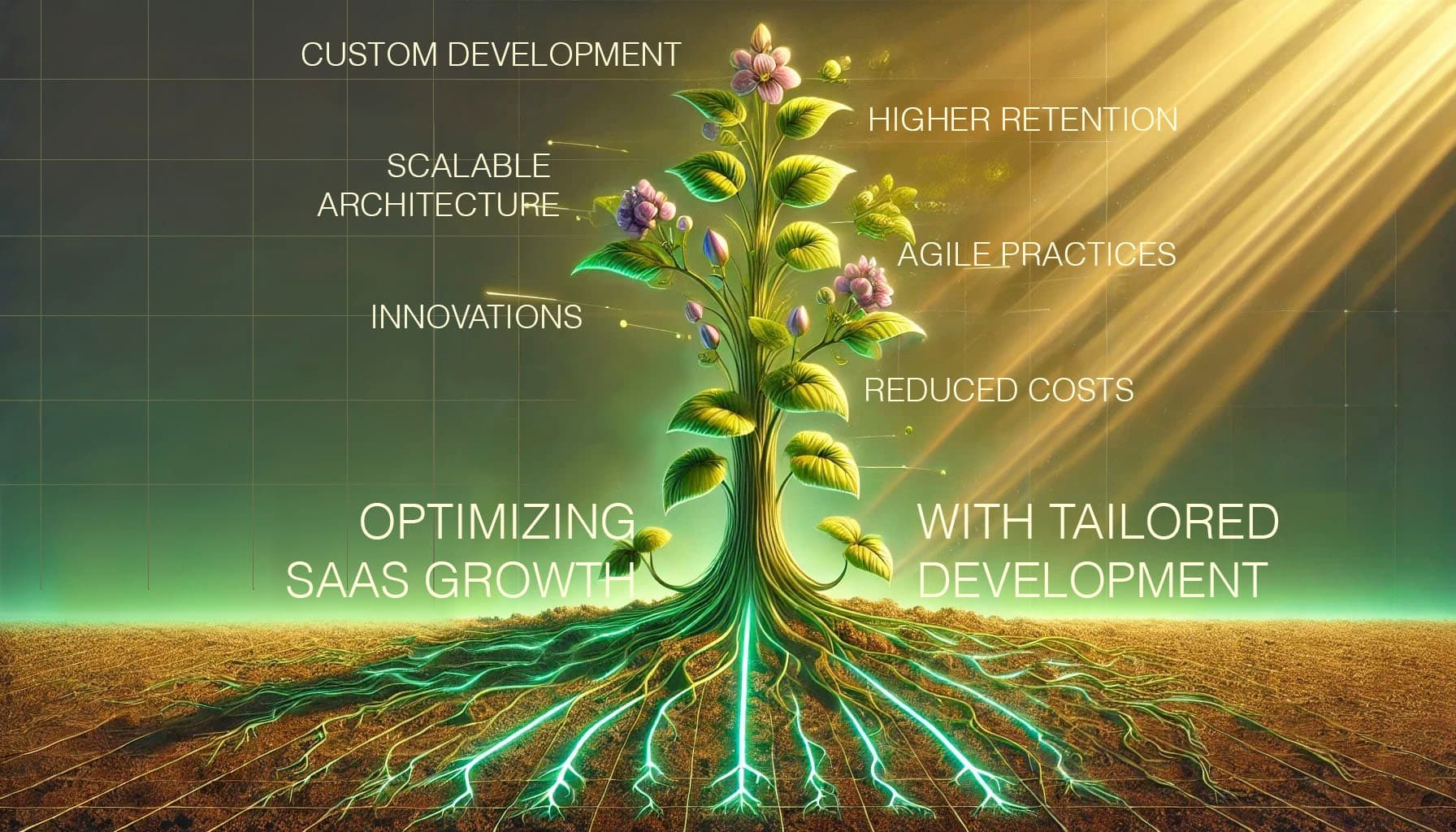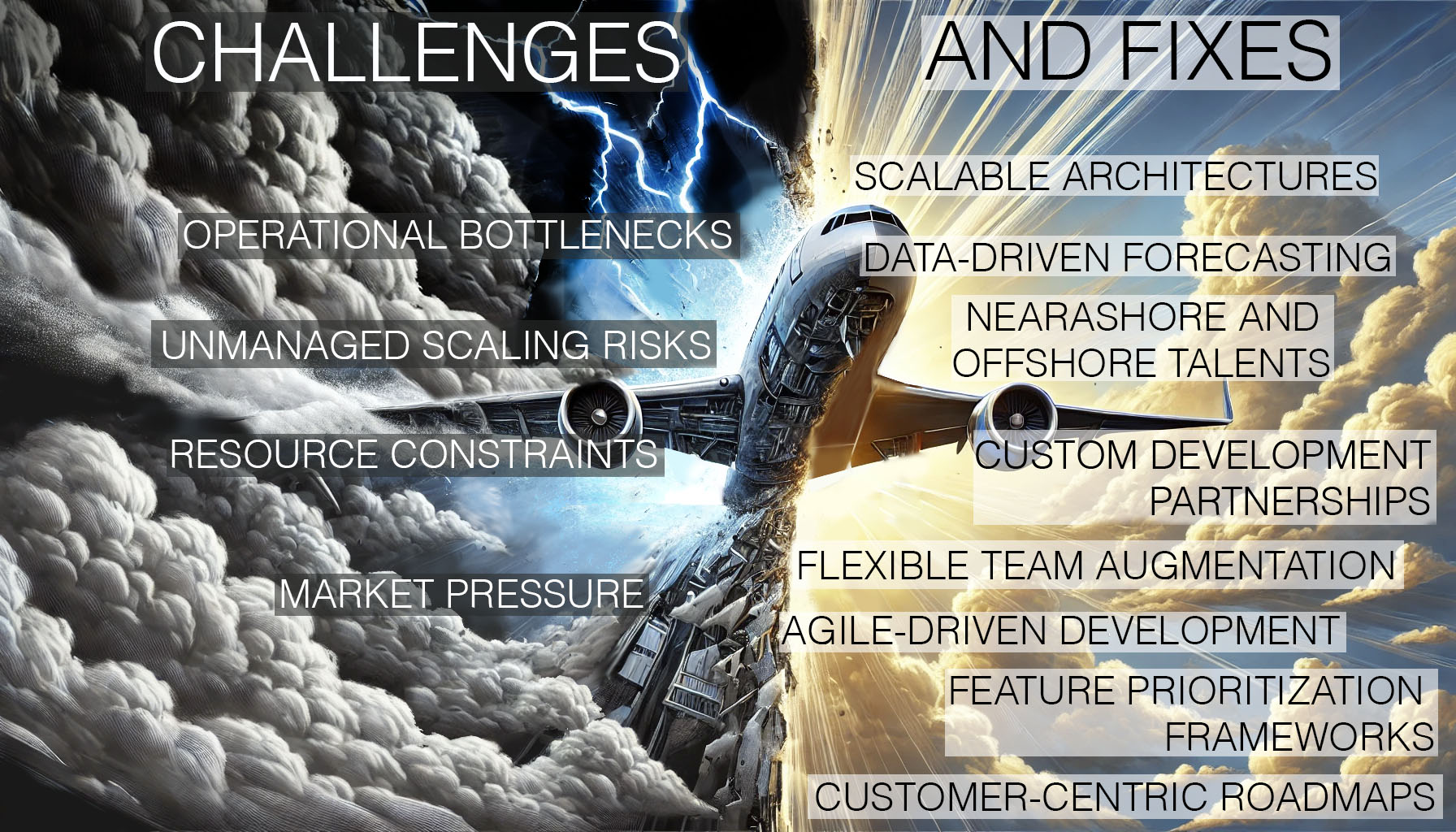Supercharge SaaS growth: Leveraging custom software development strategies

Introduction: Why tailored software development matters for SaaS growth
The SaaS world changes very fast. Businesses are scaling, investors expect faster returns, and users demand seamless experiences. Off-the-shelf solutions can’t meet these demands. The growth of SaaS companies can be powered by custom-built software tailored to their goals, industry challenges, and future expansion.
The UB Ventures SaaS Annual Report 2023-2024 emphasizes the rise of vertical SaaS as a key growth strategy in Japan, addressing specific industry needs like healthcare, construction, and logistics.
What’s at stake?
SaaS companies face multiple pressures: accelerating time-to-market, managing technical debt, and ensuring profitability. Industry reports show that businesses leveraging tailored development often grow twice as fast, reduce operational costs by 40%, and achieve higher customer retention. Why? Custom solutions transform rigid frameworks into adaptable, scalable systems.
Supercharge SaaS growth: Leveraging custom software development strategies — you are here
Understanding SaaS growth challenges
Scaling a SaaS business is like building a plane while flying it — you can’t afford to slow down, but missteps can be costly. SaaS companies face unique challenges that demand tailored solutions to maintain momentum and stay competitive. According to the UB Ventures SaaS Annual Report 2023-2024, many Japanese SaaS companies are shifting focus to scalable solutions through multi-product strategies.
Here are three critical growth obstacles and how custom development can turn them into opportunities.

1. Rapid SaaS growth needs
The bottleneck:
Growth is exciting — until your infrastructure, processes, and team size can’t keep up. Common pitfalls include:
- Operational bottlenecks. Expanding user bases can overwhelm back-end systems, causing slow response times and dreaded downtimes.
- Unoptimized scaling risks. Overzealous expansion can drain cash if infrastructure upgrades and team hires aren’t aligned with real-time needs.
The fix:
- Scalable architectures. Invest in cloud-native, modular platforms that scale on demand. Tools like Kubernetes for dynamic scaling or AWS Lambda for serverless execution can keep systems flexible.
- Data-driven forecasting. Use predictive analytics to adjust resources proactively instead of reacting after failures occur.
2. Resource constraints
The bottleneck:
Finding top-tier developers can feel like fishing in a drought — especially when specialized skills like AI, blockchain, or cybersecurity are needed. The high cost and lengthy hiring process for in-house teams only compound the issue.
The fix:
- Nearshore/offshore talent pools. Tap into global tech hubs in Eastern Europe, Latin America, or Southeast Asia for specialized roles.
- Tailored development partnerships. Collaborate with dedicated development teams that bring expertise and scalability without recruitment hassles.
- Flexible team augmentation. Scale teams up or down based on project milestones with pre-vetted developers ready to hit the ground running.
3. Market pressures
The bottleneck:
In SaaS, being slow is worse than being wrong. Customers expect continuous improvements, and missing the market window can lead to lost revenue and declining user retention.
The fix:
- Agile-driven development. Break development into sprints for continuous updates and faster releases.
- Feature prioritization frameworks. Use methods like MoSCoW (Must-have, Should-have, Could-have, Won’t-have) to focus on high-impact updates.
- Customer-centric roadmaps. Gather feedback through analytics and surveys to guide future features and updates.
Best practices for custom SaaS development
Building a scalable SaaS platform goes beyond writing code. It’s about developing a product that grows with your business. This involves using modern frameworks, ensuring top-notch quality, and setting up clear development processes. Here are the best practices SaaS companies can adopt to stay ahead.
1. Agile discovery and prototyping
SaaS success depends on quick updates and user-driven features. Agile discovery validates ideas early, reduces risks, and keeps products aligned with market demands. Prototyping turns concepts into interactive models for faster feedback.
How you can approach it:
- Define core business goals.
- Assemble a cross-functional team of developers, product managers, and designers.
- Conduct market research and create user personas.
- Build low-fidelity prototypes and test them with real users.
- Adjust features and refine prototypes in sprints.
Tools you’ll appreciate:
- Figma. Collaborative UI design
- Adobe XD. Interactive prototyping
- Miro. Brainstorming and ideation sessions
Frameworks worth considering:
- Scrum. Sprints and regular progress checks
- Kanban. Visual task management for continuous workflows
- Extreme Programming. Focus on quality and fast releases
Read more about Agile discovery and prototyping for SaaS companies.
2. Selecting the right tech stack
Your tech stack shapes your platform’s performance, scalability, and security. The right tools reduce downtime, streamline updates, and simplify long-term maintenance.
What to focus on:
- Tools that support data growth and secure sensitive information
- Frameworks with strong community support for faster troubleshooting and innovation
Tech stack must-haves:
- Frontend. React (modular), Vue.js (lightweight), Angular (enterprise-level), Next.js (high-performance)
- Backend. Node.js (scalable), Django (secure), Ruby on Rails (startup-friendly), Spring Boot (enterprise-grade)
- Databases. PostgreSQL (reliable), MongoDB (flexible), Firebase (real-time updates)
- Infrastructure tools. Docker, Kubernetes, AWS/Azure/GCP, Terraform (for streamlined deployments
- Emerging tech tools. Bun (high-performance JavaScript runtime with built-in package management), Vite (lightning-fast frontend build tool with Hot Module Replacement (HMR).
Read more about the proper selection of a tech stack.
3. Ensuring quality and transparency
Consistent quality builds trust, while transparency prevents delays and costly errors. Clear deliverables, timelines, and defined ownership terms maximize understanding.
How to get it right:
- Automate tests and conduct frequent code reviews.
- Use real-time collaboration tools.
- Define clear project deliverables, timelines, and accountability terms.
Key tools and strategies:
Overcoming SaaS growth and development challenges
SaaS development is inherently complex, requiring the right balance of people, processes, and technologies. Your SaaS company can overcome freelancer reliability, knowledge transfer, and future-proofing challenges to reduce operational risks and scale effectively. Here’s a step-by-step guide to implementing tailored solutions for long-term success.
Key SaaS development challenges and tailored solutions
1. Managing freelancers vs. Contracting dedicated teams

The challenge:
Freelancers can struggle with project consistency, accountability, and meeting deadlines due to multiple commitments or limited resources. Scope creep and quality issues arise when there’s no dedicated project oversight.
Solution: Switch to a dedicated development team
Why it works:
- Reliability. Dedicated teams sign contracts guaranteeing project completion and quality standards.
- Quality control. Teams follow industry best practices like automated testing, continuous integration, and peer code reviews.
- Project stability. Long-term contracts reduce turnover risks, ensuring continuous development.
How to implement:
- Define project scope and expectations:
- Document project requirements, deliverables, and timelines.
- Use tools like Jira or Trello for task tracking and progress monitoring.
- Build a contractor selection process:
- Evaluate vendors based on case studies, client references, and proven expertise.
- Conduct technical tests with real-world coding assignments.
- Set clear accountability metrics:
- Establish measurable KPIs such as on-time delivery and sprint completion rates.
- Schedule weekly progress reviews using tools like Zoom or Microsoft Teams.
2. Knowledge transfer and maintenance

The challenge:
Knowledge silos can disrupt development when key team members leave or contractors disengage after project completion. A lack of process documentation hinders onboarding and long-term maintenance.
Solution: Implement knowledge transfer frameworks
Why it works:
- Documentation: Comprehensive records enable quick onboarding and smooth transitions.
- Cross-functional teams: Collaboration prevents reliance on a single team member.
- Process continuity: Standardized protocols reduce long-term technical debt.
How to implement:
- Create a central knowledge repository:
- Use platforms like Confluence, Notion, or GitHub Wikis to store technical documentation, process guides, and system diagrams.
- Establish development playbooks:
- Develop step-by-step guides covering setup, coding standards, and deployment processes.
- Organize knowledge-sharing sessions:
- Hold quarterly knowledge-sharing workshops between in-house and outsourced teams.
- Automate onboarding workflows:
- Use tools like Asana or Monday.com to create onboarding checklists.
3. Future-proofing SaaS growth
The challenge:
As SaaS platforms grow, technical debt from outdated technologies, inefficient system architecture, and limited deployment methods can hinder scalability and increase maintenance costs.
Solution: Adopt scalable, cloud-native architectures
Why it works:
- Performance: Cloud-based platforms efficiently handle fluctuating workloads.
- Reduced maintenance costs: Automated processes and best practices lower expenses.
- Seamless updates: CI/CD pipelines allow for continuous releases with minimal downtime.
How to implement:
- Upgrade to cloud infrastructure:
- Choose cloud providers like AWS, Azure, or Google Cloud Platform.
- Containerize applications:
- Deploy using Docker containers for consistent environments across development, testing, and production.
- Automate deployment with CI/CD pipelines:
- Use tools like Jenkins, GitHub Actions, or Azure DevOps for automated builds, tests, and deployments.
- Enable real-time monitoring:
- Integrate tools like New Relic, Datadog, or AWS CloudWatch for incident detection and monitoring.
Step-by-step implementation plan
Step 1: Contractor selection and onboarding
Purpose: Build long-term partnerships with capable development teams.
Actionable steps:
- Define role requirements. Detail required skills and industry expertise.
- Create a vendor evaluation scorecard. Rate vendors based on relevant projects, certifications, and client testimonials.
- Conduct technical tests and interviews. Evaluate developers with real-world tasks and interviews.
- Run a pilot project. Start with a small project to test compatibility.
Step 2: Establishing clear project frameworks
Purpose: Define project deliverables, timelines, and performance metrics.
Actionable steps:
- Set SMART goals. Ensure goals are Specific, Measurable, Achievable, Relevant, and Time-bound.
- Create a project roadmap. Develop a timeline with clear milestones.
- Use project management tools. Track tasks with Jira, Asana, or Trello.
- Schedule bi-weekly reviews. Conduct sprint reviews, retrospectives, and demos.
Step 3: Knowledge transfer setup
Purpose: Ensure uninterrupted progress through comprehensive process documentation.
Actionable steps:
- Centralize documentation. Use Confluence or Notion for tech specs, process flows, and coding guidelines.
- Conduct handover sessions. Record walkthroughs on API usage, system architecture, and feature implementation.
- Develop playbooks. Write guides covering setup, testing, and deployment.
Step 4: Continuous monitoring and support
Purpose: Ensure optimal performance with real-time issue alerts and monitoring.
Actionable steps:
- Set up monitoring tools. Use New Relic, Datadog, or AWS CloudWatch.
- Define monitoring KPIs. Track server response times, database performance, and API request failures.
- Automate alerts and incident reports. Use tools like Slack or email alerts for critical issues.
- Schedule monthly audits. Conduct performance reviews and optimize systems accordingly.
Case studies: Success stories in SaaS growth
Achieving SaaS success requires strategic development choices, from leveraging modular architectures to partnering with specialized teams. These examples illustrate how SaaS companies scaled operations, modernized platforms, and met industry-specific needs by applying custom development strategies.
How SaaS startup achieved growth with modular development
Example:
A SaaS startup scaling from MVP to market leader
Tailored solutions used:
- Modular architecture. The startup adopted a modular tech stack enabling feature releases without disrupting core services. This reduced downtime and facilitated smoother updates.
- Nearshore teams. They partnered with nearshore developers to scale their engineering team, cutting development costs by 40% while ensuring 24/7 project progress.
Key outcomes:
- Doubled product development speed.
- Reduced operational costs by 40%.
- Improved feature delivery consistency.
Actionable strategy:
- Implement modular development to future-proof products.
- Explore nearshore partnerships to scale technical teams cost-effectively.
How enterprise SaaS overcame legacy challenges
Example:
Migrating a legacy SaaS platform to microservices
Key outcomes:
- Improved scalability. The platform transitioned from a monolithic structure to microservices, enabling on-demand scaling.
- Faster time-to-market. Deployment cycles shortened from quarterly to bi-weekly releases.
Actionable strategy:
- Break down monolithic systems into microservices for easier scaling.
- Use CI/CD pipelines to accelerate releases.
How niche SaaS acquired expertise
Example:
Healthcare SaaS leveraging domain-specific expertise
Results:
- Compliance achieved. Partnering with healthcare IT experts ensured adherence to industry regulations like HIPAA.
- Niche demands met. Advanced features like secure patient portals and real-time health monitoring were implemented seamlessly.
Actionable strategy:
- Collaborate with domain-specific experts to meet industry-specific compliance and technical standards.
- Prioritize regulatory compliance early in the development lifecycle.
The future of SaaS development: Key trends and strategic directions
The SaaS industry is evolving rapidly due to emerging technologies, continuous improvement practices, and a growing focus on sustainability. Here are the core areas shaping the future of SaaS development.
1. Emerging technological trends
AI integration for personalized experiences
Key innovations:
- Dynamic content customization. SaaS platforms analyze user behavior to provide tailored recommendations and personalized interfaces.
- Predictive analytics. Platforms forecast user actions to suggest relevant features, boosting engagement and retention.
Impact:
- Increased customer satisfaction and loyalty.
- Improved revenue through personalized product offerings.
Blockchain for FinTech security
Applications:
- Secure transactions. Blockchain's decentralized, tamper-proof architecture ensures transparent and immutable transactions, reducing fraud risks.
- Regulatory compliance. Auditable transaction records simplify adherence to financial regulations.
Impact:
- Enhanced customer trust through transparent operations.
- Reduced costs associated with fraud prevention and compliance management.
Advanced analytics for real-time decisions
Core features:
- Data-driven insights. SaaS platforms extract actionable insights into user behavior and operational metrics.
- Automated monitoring. Continuous performance tracking enables proactive market response.
Impact:
- Faster product improvements.
- Enhanced operational efficiency through real-time reporting.
2. Continuous improvement practices
Agile development for faster updates
Key practices:
- Sprint planning. Development teams divide work into smaller tasks for manageable progress.
- Regular reviews. Retrospectives and reviews drive continuous learning and process improvement.
Impact:
- Reduced time-to-market for new features.
- Higher product quality through regular testing and validation.
Performance monitoring and feedback loops
Best practices:
- Performance dashboards. Tools like Google Analytics and Datadog provide system health insights and user behavior tracking.
- User feedback mechanisms. In-app surveys and feature requests ensure customer-driven development.
Impact:
- More responsive development cycles.
- Increased customer satisfaction through prioritized updates.
3. Sustainability in SaaS development

Eco-friendly software architectures
Key initiatives:
- Energy-efficient code. Optimized algorithms reduce computing power consumption.
- Green hosting providers. Cloud services powered by renewable energy sources lower the carbon footprint.
Impact:
- Reduced operating costs through energy efficiency.
- Positive environmental impact, enhancing brand reputation.
Minimizing server usage with smart designs
Best practices:
- Resource optimization: Load balancing and workload distribution prevent server overuse.
- Carbon footprint measurement: Tracking energy consumption helps reduce environmental impact.
Impact:
- Lower carbon emissions.
- Cost-effective scaling through efficient resource management.
Final takeaway
Creating a platform aimed at SaaS growth goes beyond writing code and means crafting a solution that evolves with your business. Use Agile practices for smarter development, choose a future-proof tech stack, and ensure transparency through quality processes. Stay ahead by embracing modern tools like Bun and Vite for speed and efficiency.
Ready to turn your SaaS vision into reality? Start strong, iterate fast, and never stop improving.
Egor Kaleynik
IT-oriented marketer with B2B Content Marketing superpower. HackerNoon Contributor of the Year 2021 Winner – MARKETING. Generative AI enthusiast.
Featured in: Hackernoon.com, Customerthink.com, DZone.com, Medium.com/swlh
More info: https://muckrack.com/egor-kaleynik